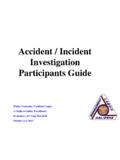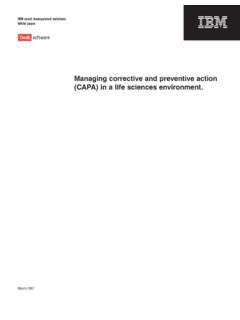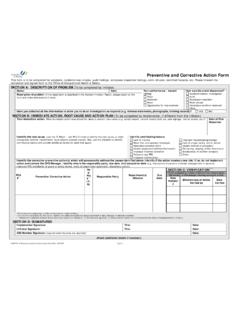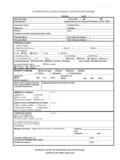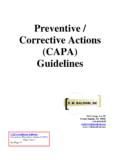Transcription of Remedial Investigation/Feasibility Study (RI/FS): Process ...
1 IiiContentsPageAcknowledgementsvAcronyms viiIntroductionxiiiModule 1 Management Collection Plan Preparation1-111 Module 2 Site Management and 3 Treatability Treatability Results3-33 Module 4 Development and Screening of Action and Process Option Screening4-41 Module 5 Detailed Analysis of Study Report5-97 Module 6 Remedy Selection and of Changes6-155 Module 7 Streamlined Approach For Environmental During Scoping and Remedial Investigation/Feasibility During Remedial Design and Remedial Action7-39ivContents(continued)PageModul e 8 Streamlining Case Transformer Site (DQO Example) Spring Quarry Site (Observational Approach Example)8-27 GlossaryvAcknowledgementsThis document was developed by the Department of Energy's Office of Environmental Guidance,RCRA/CERCLA Division and Office of Program Support, Regulatory Compliance Division, and withassistance provided by Pacific Northwest Laboratory and technical support provided by CH2M HILL,Incorporated and ICF Kaiser Engineers, Incorporated.
2 The CH2M HILL/ICF project team included ProjectManager Jeff Smyth (CH2M HILL, Richland), Lead Technical Specialist Steve Wilhelm (CH2M HILL,Corvallis), Lead Regulatory Specialist Craig Cheney (Project Performance Corp.; formerly with ICF KaiserEngineers, Fairfax), and Technical Writer Gail Payne (CH2M HILL, Oak Ridge).DOE staff and contractors who contributed to the development of this document include:Claude Magnuson, DOE-HQ, EM-431 Steve Golian, DOE-HQ, EM-221 Dave Bottrell, DOE-HQ, EM-563 Karen Reed, DOE, Weldon SpringBob Quinn, Pacific Northwest Laboratory, RichlandLarry Holm, CH2M HILL, Oak RidgeJulie Pfeffer, CH2M HILL, Oak RidgeJesse Tremaine, CH2M HILL, Oak RidgeShannon Gresham, CH2M HILL, Oak RidgeLynn Kristich, CH2M HILL, Oak RidgeSam Gianti, CH2M HILL, RestonGaynor Dawson, ICF Kaiser Engineers, RichlandRick Ferguson, Jacobs Engineering, Weldon SpringKevin Hull, MACTEC, AlbuquerqueJudith Bradbury, Pacific Northwest Laboratory, Washington.
3 Energy CommissionARAR sapplicable or relevant and appropriate requirementsATSDRA gency for Toxic Substances and Disease RegistryAWQCA mbient Water Quality CriteriaBAFbioaccumulation factorBCFbioconcentration factorBODbiological oxygen demandBREbaseline risk evaluationBtuBritish thermal unitCAAC lean Air ActCAMUC orrective Action Management UnitCERCLAC omprehensive Environmental Response, Compensation, and Liability ActCFRCode of Federal Regulationscfscubic feet per secondCLPC ontract Laboratory ProgramCODchemical oxygen demandCPMcounts per minuteCRPC ommunity Relations PlanCSLC lose Support LaboratoryCWAC lean Water ActD&Ddecontamination and decommissioningDNAPL dense non-aqueous phase liquidDOED epartment of EnergyDPMdisintegrations per minuteDQOdata quality objectiveviiiEAEnvironmental AssessmentEISE nvironmental Impact StatementEMSL/EPICE nvironmental Monitoring Support Laboratory/Environmental Photographic InformationCenterEPAE nvironmental Protection AgencyEREnvironmental Restoration (DOE Program)
4 ERMCE nvironmental Restoration Management ContractERPME nvironmental Restoration Project ManagerESAE ndangered Species ActESDE xplanation of Significant DifferencesEUexposure unitFIT/TATF ield investigation Team/Technical Assistance TeamFONSIF inding of No Significant ImpactFSLF ield Support LaboratoryFSPF ield Sampling PlanFUSRAPF ormerly Utilized Sites Remedial Action ProgramGMGeiger-Muellergpmgallons per minuteGRAgeneral response actionHEASTH ealth Effects Assessment Summary TablesHIhazard indexHLWhigh-level wasteHQhazard quotientHRSH azard Ranking SystemHSPH ealth and Safety PlanIDWinvestigation-derived wasteIEion exchangeixIRISI ntegrated Risk Information SystemLDRland disposal restrictionLFIlimited field investigationLLWlow-level wasteLNAPL light non-aqueous phase liquidMCEmaximum credible earthquakeMCLM aximum Contaminant LevelMDAminimum detectable activityMEKmethylethyl ketoneM&Omanagement and operating (contractor)
5 MPmultiportMS/MSDmatrix spike/matrix spike duplicateNAPLnon-aqueous phase liquidNCPN ational Oil and Hazardous Substances Pollution Contingency PlanNEPAN ational Environmental Policy ActNPDESN ational Pollutant Discharge Elimination SystemNPLN ational Priorities ListNRCN uclear Regulatory CommissionO&MOperations and MaintenanceORNLOak Ridge National LaboratoryOSCOn-Scene CoordinatorOSHAO ccupational Safety and Health AdministrationOSWERO ffice of Solid Waste and Emergency ResponseOUoperable unitPAPreliminary AssessmentPAHpolycyclic aromatic hydrocarbonPARCC precision, accuracy, representativeness, completeness, and comparabilityxPCBpolychlorinated biphenylPERpreliminary engineering reportPMFprobable maximum floodppmparts per millionPRGpreliminary remediation goalQAMSQ uality Assurance Management Staff (EPA)
6 QAPPQ uality Assurance Project PlanQA/QCquality assurance/quality controlRARemedial ActionRAGSRisk Assessment Guidance for SuperfundRAOremedial action objectiveRASR outine Analytical ServicesRCRAR esource Conservation and Recovery ActRD&Dresearch, development, and demonstrationRD/RARemedial Design/ Remedial ActionRfDreference doseRFPrequest for proposalRI/FSRemedial Investigation/Feasibility StudyRMEreasonable maximum exposureRODrecord of decisionRPMR emedial Project ManagerRUremediation unitSAFERS treamlined Approach For Environmental RestorationSAPS ampling and Analysis PlanSARAS uperfund Amendments and Reauthorization ActSCSRSite Characterization Summary ReportSFslope factorxiSISite InspectionSMOAS uperfund Memorandum of AgreementSOPS tandard Operating ProcedureTBCto be consideredTCEtrichloroetheneTCLPT oxicity Characteristic Leaching ProcedureTICT entatively Identified CompoundsTOCtotal organic carbonTRUtransuranicTDStotal dissolved solidsTSCAT oxic Substances Control ActTSDtreatment, storage.
7 And disposalTSDF treatment, storage, or disposal facilityTSStotal suspended solidsUMTRAPU ranium Mill Tailings Remedial Action Geological SurveyVGAC vapor-phase granular activated carbonVOCvolatile organic compoundWSSRAPW eldon Spring Site Remedial Action ProjectxiiiIntroductionPurposeThis manual provides detailed guidance on Remedial Investigation/Feasibility Studies (RI/FSs) conductedpursuant to the Comprehensive Environmental Response, Compensation, and Liability Act (CERCLA) atDepartment of Energy (DOE) facilities. The purpose of the RI/FS, to assess the risk posed by a hazardouswaste site and to determine the best way to reduce that risk, and its structure (site characterization, riskassessment, screening and detailed analysis of alternatives, etc.) is defined in the National Oil and HazardousSubstances Pollution Contingency Plan (NCP) and further explained in the Environmental Protection Agency's(EPA's) Guidance for Conducting Remedial Investigations and feasibility Studies Under CERCLA (InterimFinal) EPA 540/G-89/004, OSWER Directive , October 1988.
8 Though issued in 1988, the EPAguidance remains an excellent source of information on the conduct and structure of an RI/FS. However, sincethat time, EPA has developed numerous supplemental directives, fact sheets, memoranda, and other types ofguidance that further explain and define, at a more detailed level, the various aspects of an RI/FS. Additionally, the NCP requirements and EPA's RI/FS guidance were developed to respond to sites where EPAor private parties were conducting the cleanup; neither the NCP nor the guidance address the considerationsthat are unique to Federal document makes use of supplemental RI/FS-related guidance that EPA has developed since its initialdocument was issued in 1988, incorporates practical lessons learned in more than 12 years of experience inCERCLA hazardous site remediation, and drawing on those lessons, introduces the Streamlined Approach ForEnvironmental Restoration (SAFER), developed by DOE as a way to proceed quickly and efficiently throughthe RI/FS Process at DOE facilities.
9 Thus as its title implies, this guidance is intended to describe in detail theprocess and component elements of an RI/FS, as well as techniques to manage the RI/FS effectively. To helpaccomplish this, the document also makes copious use of examples, many taken from actual RI/FSs beingconducted at DOE , as stated above, the ultimate goal of the RI/FS Process is the selection of remedy that will reducethe risk posed by a contaminated site. Although not formally a part of the actual RI/FS Process and, therefore,not included in EPA's 1988 guidance, remedy selection has its own procedural aspects and documentationrequirements. Therefore, this document provides detailed information on the remedy selection Process andaccompanying documentation, including the Proposed Plan and the Record of Decision (ROD).
10 Again,examples are , the RI/FS Process tends to focus on long-term goals and Remedial actions. However, options exist forusing short-term actions that may be used to quickly reduce actual or potential risk during the RI/FS Process . These actions may be taken under the NCP's removal or Remedial authorities, and they are an integral part ofthe SAFER Process . This document points out where, when, and how those various actions may be takenduring the conduct of an guidance document is primarily intended for DOE personnel with line-management responsibility forenvironmental restoration efforts conducted pursuant to CERCLA at DOE facilities. It describes, in detail, thesteps in the RI/FS Process , explains how each should be conducted and what should be accomplished, anddefines what should be included in the RI and FS reports and in the remedy selection documentation.
